

14 disruptive food-tech startups that will change how we eat. Food technology is all about piling your plate with safer, cheaper, fresher, more nutritious and environmentally friendly edibles.

Continuing in the tradition of older cousins such as decaffeination and freeze-drying, today’s food-tech dabbles in tissue engineering, stem-cell research, microbiology and nanotechnology. Given Israelis’ expertise in these areas, it’s only natural that investors and industrialists in the multibillion-dollar food-tech industry are paying attention to food-tech trends in the startup nation. Signs of this trend include the construction of a huge hub for food innovation and research in the Upper Galilee; and the establishment of The Kitchen FoodTech Hub in Ashdod and FoodLab Capital in Rishpon to invest in Israeli food-tech startups. World's largest Indoor vertical farm to produce greens without sun, soil or water.
The world's largest, and possibly most sophisticated indoor farm -- where greens grow without sun, soil or water.
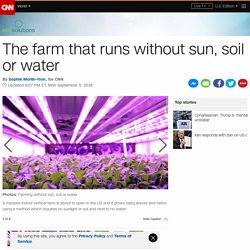
Well, almost no water. AeroFarms, the company behind the venture, say they will use 95% less water than a conventional outdoor farm. Set to open in September in Newark, New Jersey, the 69,000-square-foot farm will be hosted in a converted steel factory. Urban Farms Provide More Than Food. 12.27.13 | By Stuart Fox Facebook Twitter Naturally, urban farming isn’t new.
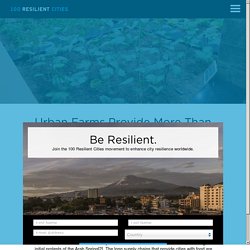
The British government has required cities to provide allotment plots for over 100 years, and many American city dwellers tended “victory gardens” during World War Two. But in recent years, cities from Dhaka to Doha to Detroit have discovered that urban farming is more valuable than ever. Ikea to introduce cute countertop hydroponic garden kit. The indoor gardening system with a Swedish accent will help you grow your own lettuce and herbs year round.
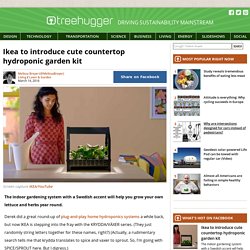
Derek did a great round-up of plug-and-play home hydroponics systems a while back, but now IKEA is stepping into the fray with the KRYDDA/VÄXER series. (They just randomly string letters together for these names, right?) (Actually, a rudimentary search tells me that krydda translates to spice and vaxer to sprout. So, I'm going with SPICE/SPROUT here. This Berlin supermarket has a vertical micro-farm inside it. INFARM is bringing fresh greens and herbs into the supermarket with its tiny vertical farms, which both grow and display the produce.
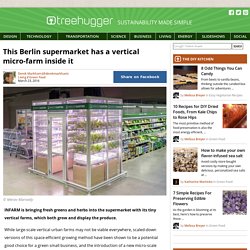
While large-scale vertical urban farms may not be viable everywhere, scaled-down versions of this space-efficient growing method have been shown to be a potential good choice for a green small business, and the introduction of a new micro-scale offering from INFARM could bring the crops right into the grocery aisle. Introducing "farming as a service," INFARM has launched what it calls "the first in-store farm in Europe" at a Berlin METRO supermarket location, with the mini-farm being dubbed simply "Kräuter Garten" (herb garden).
Will Urban Agriculture Last? In a survey of 370 urban farmers working in the U.S., researchers found that roughly two-thirds of farmers weren’t making a living.

Only a third of the urban farms were operating as nonprofits. But the survey also demonstrated the huge variety between what’s considered an urban farm–and it’s likely that high-tech vertical farms, at one end of the spectrum, may end up much more financially successful than smaller counterparts. When the survey was conducted in 2012, vertical indoor farming was at the early stages. Top 10 Best LED Grow Lights: The Heavy Power List. LED grow lights are a hot topic among hydroponic gardening enthusiasts.

LEDs are an efficient and effective solution for hydroponic lighting, and can end up saving growers hundreds or even thousands of dollars in energy costs over the years. This article includes our favorite LED light brands and their products, including individual bulbs as well as larger panels. Whether you are a hobbyist with a small vegetable garden, or a professional grower with an entire greenhouse, you will find LEDs in this list to meet your needs. Video & Photo Gallery.
How sustainable is vertical farming? The world's food system is beginning to strain under a global population expected to reach nine billion by 2050, by which time the planet's arable land is projected to be half of what it was in the 1970s.
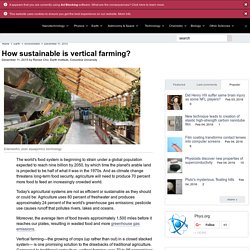
And as climate change threatens long-term food security, agriculture will need to produce 70 percent more food to feed an increasingly crowded world. Today's agricultural systems are not as efficient or sustainable as they should or could be: Agriculture uses 80 percent of freshwater and produces approximately 24 percent of the world's greenhouse gas emissions; pesticide use causes runoff that pollutes rivers, lakes and oceans.
Moreover, the average item of food travels approximately 1,500 miles before it reaches our plates, resulting in wasted food and more greenhouse gas emissions. Vertical farming—the growing of crops (up rather than out) in a closed stacked system— is one promising solution to the drawbacks of traditional agriculture. Is the future of vegetable farming indoors? HOMER — The future of vegetable farming in upstate New York might be under plastic.

Behind a century-old yellow farmhouse on Route 11, an electric water pump bubbles away beneath translucent plastic sheeting on top of a simple metal greenhouse frame. The water is home to schools of tilapia, a hardy freshwater fish known as the species that miraculously fed the Biblical multitudes. The pumps lift the nutrient-rich water to three rows of troughs where floating plastic trays hold thousands of tiny baby arugulas, kales, cabbages, kohlrabies, red amaranth, cress and spicy mustard that can fetch $30 a pound from fine-dining restaurants in New York City.
Urban Farming in Israel - LivinGreen. What is Urban Farming?
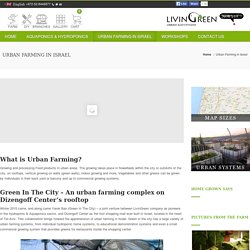
Growing and processing Food products in urban areas. The growing takes place in flowerbeds within the city or outskirts of the city, on rooftops, vertical growing on walls (green walls), indoor growing and more. Vegetables and other greens can be grown by Individuals in their back yard or balcony and up to commercial growing systems. Green In The City – An urban farming complex on Dizengoff Center’s rooftop.
The World's First Robot Farm Requires No (Human) Farmers At All. By Dan Nosowitz on October 7, 2015 Indoor farming, hyper-futuristic and spotless high-tech farms, have long been pegged as a possible future of farming. They're low-profile, easy on the environment, and can be made to produce massive quantities of food, especially quick-growing crops like lettuces, very easily. Say Hello To The (Soon To Be) World's Largest Indoor Vertical Farm. By Dan Nosowitz on March 17, 2015 Some 15 miles from Manhattan, monster investors are setting up what will be one of the most impressive indoor urban farming units in history.
It's called AeroFarms. Vertical farming is typically done in tall buildings with lots of sunlight; abandoned skyscrapers are ideal. Salad Inc. Can plant factories save us from climate change? By Monica Kim on December 17, 2014 After an earthquake and tsunami decimated northeast Japan in 2011 — an unexpected weather incident that scientists are still struggling to understand — the Japanese government built Sanriku Fukko National Park. A triumph of weather-conscious design, built in part to revitalize the area’s flagging economy, the park boasts reconstructed pine forests, tidal flats and seagrass beds hugging the coast. And deep within the park’s faux-natural artifice sits exactly one farm. SPREAD's Vegetable Factories. BrightFarms. US(IL): Vertical farming on rise with organic basil. Microgreens program also strong, new markets on horizonUS(IL): Vertical farming on rise with organic basil As aquaponic and hydroponic technology continues to advance, major players in the vertical farming industry are planning to expand into new products and new territories.
FarmedHere, an organic basil and microgreens grower based out of Bedford Park, IL, is one such company. “We’re one of the largest indoor vertical farms in the country,” says Megan Klein, the company’s President. Vertical Farming Market by Functional Device. The vertical Farming market is expected reach USD 3.88 Billion by 2020, at a CAGR of 30.7% between 2015 and 2020. The base year used for study is 2014 and the forecast period is between 2015 and 2020. This report provides a detailed analysis of the market based on functional devices, growth mechanism, and geography. Why the Future Is Bright for the World’s Poorest Farmers. Fastcoexist. 'Mega' Indoor Vertical Farm: Chicago Suburb New Home To Nation's Largest Such Facility.
Farming in the Sky: Inside a Wall Street-Backed Vertical Farm. The Problem. Indoor Harvest. How sustainable is vertical farming? Dirt-Free Farming: Will Hydroponics (Finally) Take Off? Contact Us - ARO. Urban Farming in Israel - LivinGreen. Orphek LED לגדול אורות - LED לגדול אורות. - City Farms, Parks and Boston: Let’s Grow Up. Israel a vertical farming hot spot? Farmedhere indoor vertical farm.
Vertical Harvest. Orphek LED Grow Lights. How To Build A Gravity-Based PVC Aquaponic Growing System… FarmedHere. In Newark, a Vertical Indoor Farm Helps Anchor an Area’s Revival. Sky Vegetables - The Sky is the Limit! The Commercial Leader in Urban Agriculture and Farming. This Week in Virology - The Vertical Farm: Feeding the World in the 21st Century. WHAT IS VERTICAL FARMING?WHAT IS HYDROPONICS?WHAT ARE MICRO NUTRIENTS?ADVANTAGES OF VERTICAL FARMING? FOR PRELIMS AND MAINS GS PAP III. Vertical farming: Does it really stack up? Green Spirit Farms. FarmedHere. Can Cities Feed Their Inhabitants? Food Production in a Technology-driven Economy.
180° Shift: When Local Means Your Kitchen. TCLocal: food Archives. Plantscapers could produce more with less. Sustainable Agricultural Partnerships Summit. Hunger, Health and the Future of Food.